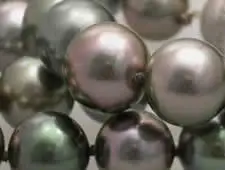A Meditation on Cultured Pearls; Part Three

The pearl has another quality, unique among gems: its beauty can be enlivened or subdued by placing it in contact with a woman’s skin. The Spanish word simpatico is a term I’ve chosen which I think best describes this somewhat mysterious quality.
A pearl, no matter how beautiful in itself, will seem to glow if it is placed in close proximity to skin of certain color, texture and tone with which it is simpatico. Gems will also stimulate a pearl. Simpatico is not simply another way of saying that some stones look good with others. It is not unlike the quality of young women in first bloom. The Mojave blue agate will, for example, have an extraordinary effect on certain pearls.
There are other factors as well that are necessary qualifications for a fine pearl. Symmetry has historically been of great importance. A perfectly round pearl was the most desired of all. However, since the introduction of the cultured pearl in the late 1920s, round pearls are no longer the great rarity they once were. The thin-skinned Akoya pearl has accustomed consumers to expect a spherical perfection of form. Who can resist the perfection of an oval or an egg shaped pearl or the sensuous curves of a pear-shape. Still there is something so elegant about a round.
A pearl’s surface may be bumpy or smooth or textured. Texture on the skin may be interpreted as coarse and if it detracts from the pearl’s beauty be a distinct negative. But, pearls of this kind, particularly freshwater pearls from China, sometimes exhibit A rainbow like iridescence caused by light rays refracting and colliding with each other as they bounce from the pearl’s surface.
Perhaps this is a visual mea culpa to make up for the baroque’s lack of formal perfection. This phenomenon is distinct from orient, which is caused by light entering the translucent crystalline layers of nacre. Technically described as light interference, this rainbow iridescence is never found in a smooth symmetrical pearl.
It may be that we are entering another golden age of pearls. In Roman times, pearls were ounce for ounce the most valuable thing on earth. The fashion for pearls has waxed and waned over the centuries at times eclipsing the value of diamonds and other crystal gems.
Today there are greater quantities of more varieties of pearl available than at any time in history. The American freshwater pearl, the Chinese freshwater pearl, black and white Southsea pearls are all available in quantity. Pearls from the Philippines, and Indonesia are new to the market.

Burmese and Baja California pearls are reentering the market. Pearl sales have increased dramatically in this decade and the pearl market has regained the luster lost in the 1930s. All these pearls are cultured but the consumer has accepted that along with variations in shape, size and color.
The pearl horizon seems clearer than at any time in the past sixty years. However, a few dark, dirty little clouds have made their appearance or should I say have been breeding. Pearl treatments have multiplied. In addition to bleaching, a venerable treatment stretching back into history, dyeing, irradiation, waxing, coating and other treatments are proliferating as the demand for pearls increases.
